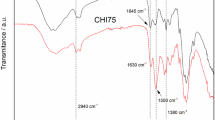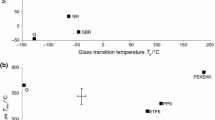Purpose
The aims of the study are to characterize the slow molecular mobility in solid raffinose in the crystalline pentahydrate form, as well as in the anhydrous amorphous form (Tg = 109°C at 5°C/min), and to analyze the differences and the similarities of the molecular motions in both forms.
Methods
Thermally stimulated depolarization current (TSDC) is used to isolate the individual modes of motion present in raffinose, in the temperature range between −165 and +60°C. From the experimental output of the TSDC experiments, the kinetic parameters associated with the different relaxational modes of motion were obtained, which allowed a detailed characterization of the distribution of relaxation times of the complex relaxations observed in raffinose. The features of the glass transition relaxation in raffinose were characterized by differential scanning calorimetry (DSC).
Results
A complex mobility was found in the crystalline form of raffinose. From the analysis of the TSDC data, we conclude that these molecular motions are local and noncooperative. A sub-Tg relaxation, or secondary process, was also detected and analyzed by TSDC in the amorphous phase. It has low activation energy and low degree of cooperativity. The glass transition was studied by DSC. The fragility index (Angell’s scale) of raffinose obtained from DSC data is m = 148.
Conclusions
TSDC proved to be an adequate technique to study the molecular mobility in the crystalline pentahydrate form of raffinose. In the amorphous form, on the other hand, the secondary relaxation was analyzed by TSDC, but the study of the glass transition relaxation was not possible by this experimental technique as a consequence of conductivity problems. The DSC study of the glass transition indicates that raffinose is an extremely fragile glass former.








Similar content being viewed by others
References
J. H. Crowe J. F. Carpenter L. M. Crowe (1998) ArticleTitleThe role of vitrification in anhydrobiosis Annu. Rev. Physiol. 60 73–103
J. Buitink O. Leprince (2004) ArticleTitleGlass formation in plant anhydrobiotes: survival in the dry state Cryobiology 48 215–228
K. Chatterjee E. Y. Shalaev R. Suryanarayanan (2005) ArticleTitleRaffinose crystallization during freeze-drying and its impact on recovery of protein activity Pharm. Res. 22 303–309
K. Kajiwara F. Franks (1997) ArticleTitleCrystalline and amorphous phases in the binary system water-raffinose J. Chem. Soc., Faraday Trans. 93 1779–1783
K. Kajiwara F. Franks P. Echlin A. L. Greer (1999) ArticleTitleStructural and dynamic properties of crystalline and amorphous phases in raffinose–water mixtures Pharm. Res. 16 1441–1448
A. Saleki-Gerhardt J. G. Stowell S. R. Byrn G. Zografi (1995) ArticleTitleHydration and dehydration of crystalline and amorphous forms of raffinose J. Pharm. Sci. 84 318–323
J. J. Moura Ramos R. Taveira-Marques H. P. Diogo (2004) ArticleTitleEstimation of the fragility index of indomethacin by DSC using the heating and cooling rate dependency of the glass transition J. Pharm. Sci. 93 1503–1507
G. Teyssèdre C. Lacabanne (1995) ArticleTitleSome considerations about the analysis of thermostimulated depolarisation peaks J. Phys., D. Appl. Phys. 28 1478–1487
N. T. Correia C. Alvarez J. J. Moura Ramos M. Descamps (2001) ArticleTitleThe β–α branching in d-sorbitol as studied by thermally stimulated depolarisation currents (TSDC) J. Phys. Chem., B 105 5663–5669
N. T. Correia J. J. Moura Ramos M. Descamps G. Collins (2001) ArticleTitleMolecular mobility and fragility in indomethacin: a thermally stimulated depolarisation currents study Pharm. Res. 18 1767–1774
J. Turnhout Particlevan (1975) Thermally Stimulated Discharge of Polymer Electrets Elsevier Sci. Pub. Co. Amsterdam
R. Chen Y. Kirsch (1981) Analysis of Thermally Stimulated Processes Pergamon Press Oxford
B. B. Sauer (2002) Thermally stimulated currents: Recent developments in characterization and analysis of polymers S. Z. D. Cheng (Eds) Handbook of Thermal Analysis and Calorimetry, Vol. 3: Applications to Polymers and Plastics, Chap. 15 Elsevier Amsterdam
J. Buitink I. J. Dries ParticleVan den F. A. Hoekstra M. Alberda M. A. Hemminga (2000) ArticleTitleHigh critical temperature above Tg may contribute to the stability of biological systems Biophys. J. 79 1119–1128
G. A. Jeffrey D. Huang (1990) ArticleTitleThe hydrogen bonding in the crystal structure of raffinose pentahydrate Carbohydr. Res. 206 173–182
B. B. Sauer P. Avakian H. W. Starkweather B. S. Hsiao (1990) Macromolecules 23 5119–5126
K. J. Crowley G. Zografi (2001) ArticleTitleThe use of thermal methods for predicting glass-former fragility Thermochim. Acta 380 79–93
C. T. Moynihan A. J. Esteal J. Wilder J. Tucker (1974) ArticleTitleDependence of the glass transition temperature on heating and cooling rates J. Phys. Chem. 76 2673–2677
R. Bohmer K. L. Ngai C. A. Angell D. J. Plazek (1993) ArticleTitleNonexponential relaxations in strong and fragile glass formers J. Chem. Phys. 99 4201–4209
R. Bohmer C. A. Angell (1994) Local and global relaxations in glass-forming materials R. Richert A. Blumen (Eds) Disorder Effects on Relaxational Processes Springer-Verlag Berlin, Heidelberg, New York
N. T. Correia C. Alvarez J. J. Moura Ramos M. Descamps (2000) ArticleTitleMolecular motions in molecular glasses as studied by thermally stimulated depolarisation currents (TSDC) Chem. Phys. 252 151–163
N. T. Correia C. Alvarez J. J. Moura Ramos M. Descamps (2000) ArticleTitleGlass transition relaxation and fragility in the molecular glass forming m-toluidine: a study by thermally stimulated depolarisation currents J. Chem. Phys. 113 3204–3211
G. P. Johari M. Goldstein (1970) ArticleTitleViscous liquids and the glass transition. II. Secondary relaxations in glasses of rigid molecules J. Chem. Phys. 53 2372–2388
Acknowledgment
S. S. Pinto gratefully acknowledges a grant from Fundação para a Ciência e a Tecnologia.
Author information
Authors and Affiliations
Corresponding author
Rights and permissions
About this article
Cite this article
Moura Ramos, J.J., Pinto, S.S. & Diogo, H.P. Molecular Mobility in Raffinose in the Crystalline Pentahydrate Form and in the Amorphous Anhydrous Form. Pharm Res 22, 1142–1148 (2005). https://doi.org/10.1007/s11095-005-5645-1
Received:
Accepted:
Published:
Issue Date:
DOI: https://doi.org/10.1007/s11095-005-5645-1




